So, I’m considering reviewing this season of The Flash, because the pilot looks interesting and I’ve always had a soft spot for the Scarlet Speedster. I’m also considering taking a storyline-by-storyline trek through the 1987-2009 Flash on-going series as a companion piece. If you are interested in reading either of these, please let me know in the comments.
In many respects, The Kilg%re and Kill the Kilg%re are indicative of Mike Baron’s approach to plotting The Flash. There’s never really a sense of an over-arching plot. It often feels like the comic is not being written with a structured story in mind. As the reader follows the story, it seems to develop and grow and move in odd directions. It’s hard to figure out exactly where any of these stories are going, because Baron himself never seems entirely certain from one moment to the next.
In a way, this style of storytelling suits The Flash as a character and as a comic. The Scarlet Speedster is all about forward momentum, a sense of urgency and dynamism. The sense that Baron is making all this up on the spot is energetic at points, because it feels like the comic is being written by the seat of his pants. However, it also means that the character and plot beats can feel arbitrary and illogical, as if to demonstrate that what works in a particular moment is not guaranteed to work in a larger context.
Mike Baron was a pretty hot property inBy Baron’s own admission, he was a regular cocaine user in the late eighties, while working on titles like Nexus, The Punisher and The Flash. He has conceded that his style may not have been the most structured:
When you do cocaine, you think you can do any damn thing. Often, I just would grab a sheet of paper and start telling a story and make it up as I went along, panel by panel. But you can’t do that really. You need a real solid idea and solid characters to build a story around.
The Kilg%re seems very much like Baron is making up as he is going along, with little real sense of how it is all supposed to fit together when he is finished.
Hearts… of Stone ended with Wally and Fran moving into a new house together. However, by the second page of The Kilg%re, Fran has moved out. She doesn’t even appear in the comic, instead leaving a not to Wally explaining that things are moving “too fast.” (I see what he did there.) This doesn’t feel like an organic plot of character development, particularly given how the two ended up closer together at the end of Hearts… of Stone.
Instead, it feels like a cynical way to have Wally single so he can enjoy a guilt-free hook-up with Tina McGee. Well, almost guilt-free. It turns out that Tina is a married woman, although her relationship status may not be as simple as that would suggest. “She’s a married woman,” Wally tells himself. “But she hasn’t lived with her husband in a year. It’s over, she says.” He has clear anxiety and discomfort about the relationship – a relationship that seems to move phenomenally quickly given the complex factors at play.
To be fair, doing a storyline like this in a comic book about the Flash was fairly bold in 1987. It was a rather complex interpersonal dynamic, one a great deal more nuanced than the traditional love triangles or “will they/won’t they?” found in popular culture. There is an interesting story to be told about the changing face of romantic and sexual relationships in the late eighties, one that reflects shifting cultural values and realities.
Of course, it doesn’t go this direction. In a revelation that is very true to Mike Baron’s plotting style, it turns out that Tina McGee’s husband is actually a super-villain. That uncomplicates matters significantly, robbing the relationship between Wally and Tina of its edge and making it seem a great deal more generic. Tina suddenly becomes just another of Wally’s inter-changeable girlfriends from this particular run.
Baron’s plotting style is obvious in other ways. Most obviously, Wally stumbles across the Kilg%re in the same way that he stumbled across Vandal Savage in Happy Birthday, Wally West. He is out running really fast, and he spots a monster. However, we are also informed that the monster can only be seen by those travelling really fast – which seems to be a rather odd observation. It feels weird that so specific an observation is dismissed so casually by the scientists studying the guy who can run seven hundred miles per hour.
The nature of the Kilg%re itself also changes dramatically as the plot demands it. It is originally an electronic life form. Wally describes it as “a creature of pure energy — it has taken to our grid like a fish to the sea.” This is a fascinating idea, and one that feels right at home in The Flash. After all, the comic is perfectly suited to all sorts of wacky pseudo-science. Indeed, an enemy composed of pure energy feels like a pretty great enemy for “the fastest man alive.”
However, there’s a sense that Baron has a bit of trouble building a plot from this set-up. The Kilg%re’s nature changes quite frequently across the two issues. At one point, the Flash discovers a cloning chamber built by the entity. It replaces one of the scientists working with Wally. Towards the end of the story, the Kilg%re builds a monstrous worm-like body with which to chase Wally. It can’t help but feel like the beauty of the premise gets lost amid these transformations and rapid shifts.
There is one particularly painful example of the unfocused plotting where the Kilg%re hijacks the national missile defence grid and threatens to “destroy New Jersey.” It launches a missile, but that missile blows up due to “faulty construction.” Ignoring the fact that this was a pretty big coincidence, the Kilg%re simply brushes past that plot to muder New Jersey. It just makes a quip about how it will build better missiles. The point is quickly forgotten, as is the fact that the Kilg%re has lots of other missiles to launch.
However, it is worth noting that The Kilg%re is very much an artefact of its time. It is a comic book very much in tune with the late eighties. When it was published in 1987, it probably seemed almost cutting edge. Ronald Reagan has a cameo in the story, and there are frequent allusions to the Russians – allusions that paint the Russians not as default antagonists, but simply awkward neighbours. Mike Baron was clearly trying to write a version of Wally West in synch with the times.
After all, the Kilg%re itself represents the sorts of anxieties and uncertainties that were in effect in the late eighties; fears about how interconnected technology might one day threaten mankind – that there may come a time when our computers no longer need us. The Kilg%re draws on the same uncertainties that had made films like The Terminator and War Games so successful and so memorable; a deep discomfort with an increasingly digital future.
Of course, there are points where The Kilg%re is even more up-front about its influences and its inspirations. When the entity seizes control of television, it appears in a form very similar to Max Headroom. There are even dancing figures visible in the background of some panels, as if to evoke the MTV origins of the character. However, once the Kilg%re unleashes itself upon the world, it adopts a form more like Chris Claremont and Bill Sienkiewicz’s Warlock, the technological lifeform created for Marvel’s New Mutants in 1984.
The Kilg%re does feel like a creature in tune with the times, even if it feels somewhat hazily defined and under-developed over the course of The Kilg%re and Kill the Kilg%re. There is definitely potential for an interesting story featuring the creature, and one that might play into the larger themes associated with The Flash. Baron generally steered clear of established Flash villains, and tended to create his own. The Kilg%re is not a terrible new villain.
Baron has admitted that the Kilg%re was one of his favourite additions to the mythos surrounding The Flash. Indeed, he was disappointed that he could not use the character more often:
I would like to do a lot more with Kilg%re. That’s my main character that I created for Flash. He and the Chunk.
What was it about Kilg%re that you liked?
He encapsulates a number of science fiction ideas that lend themselves to exciting story-telling. Dark Horse took a stab at it with a movie called Virus, which is very similar in idea to Kilg%re. It wasn’t the greatest movie in the world. It starred Jamie Lee Curtis.
The character was later incorporated into Justice League International, so it is not as if it vanished completely from DC comics’ shared continuity.
Unfortunately, there are other aspects of The Kilg%re that feel anchored in the late eighties. There is a decidedly offensive portrayal of the chef at the lab cafeteria, identified as “Mr. Gomez.” He warns Wally about “the monster on the flats”, but is portrayed as a horrible racial caricature. When Wally asks about the creature, Gomez responds, “Chure — but you’re got to be doing some speed to see it, dig?” When his supervisor complains, he replies, “Don’t bother, ma. I don’t need this jive job! I’m a dancer, man!”
These are the same sorts of racial stereotypes that made Vibe such an awful character when he was introduced in October 1984. It is genuinely cringe-worthy, particularly for a book that is consciously trying to draw young readers into the wider DC universe. After all, The Kilg%re stresses Wally West’s relative immaturity. He only turned twenty at the start of the run. Given how hard The Flash is trying to seem modern and hip, these tone-deaf moments feel particularly out of place.
Then again, there are other awkward (albeit less offensive) moments at work here. The Kilg%re opens with Wally West enjoying his newfound wealth. He is driving a pretty snazzy foreign sports car. However, there’s no getting around the fact that this is the Flash – the fastest man alive. He should need a car in order to feel speed. Having the Flash drive a sports car for recreation is like having Clark Kent learn how to fly a plane. It seems to misunderstand why that superhero’s gifts are so awesome in the first place.
Similarly, there’s no sense that Baron has figured out what to do with Wally’s newfound wealth. What does winning the lottery mean for Wally West as a person? How does it affect his relationships? How does it intrude on his work? Outside of the sports car, the only other time that Wally’s wealth comes up is when the character surveys the cafeteria at the research lab. “I’m having my own chef flown out. Do you don’t mind?” It makes Wally sound like an entitled jerk.
It’s also interesting that Baron reinforces the idea that Wally has abandoned his secret identity. Everybody knows that Wally West is the Flash. This would seem to be awkward. After all, Vandal Savage was able to attack him at his apartment and to stalk him on a date. Wally may be able to look out for himself, but announcing his identity publicly to the world would seem to put those around him in a great deal of danger. It seems like Baron isn’t quite ready to deal with the sort of issues that a lack of a secret identity should cause.
That said, there is a nice scene where Tina wonders about his costume. If everybody knows his name, why does he wear a mask? “Oh, many reasons,” he replies. “It feels good… tradition… respect for Barry… but I don’t lead a double life.” It’s a nice little conversation, one that might seem more effective or more powerful if it tied back into the rest of Baron’s work on the character. Instead, it feels rather isolated and withdrawn.
The Kilg%re and Kill the Kilg%re! continue to trace the shape of The Flash as a late eighties comic book. Unfortunately, that shape does not inspire much confidence at present.
You might be interested in our reviews of The Flash:
- City of Heroes
- Fastest Man Alive
- Flashback: (1987-2009) #3-4 – The Kilg%re/Kill the Kilgore!
Filed under: Comics | Tagged: dc comics, flash, Mike Baron, the flash, the kilg%re, wally west |















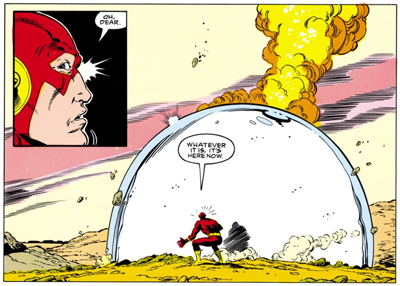

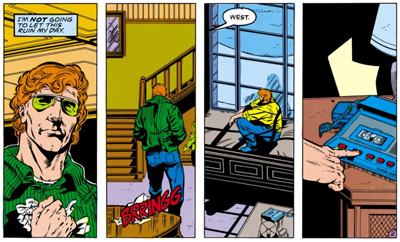

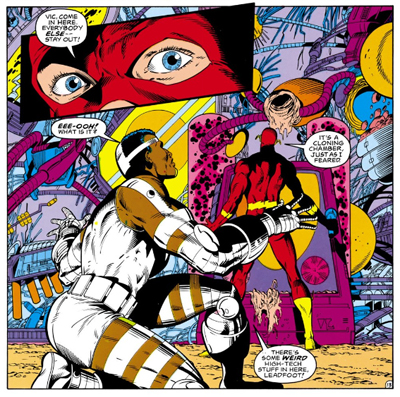


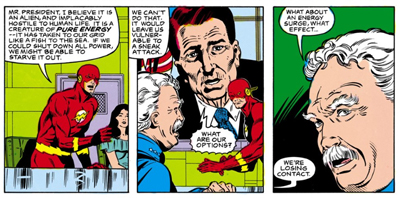


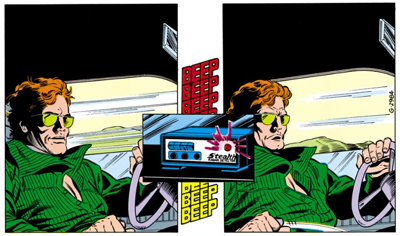
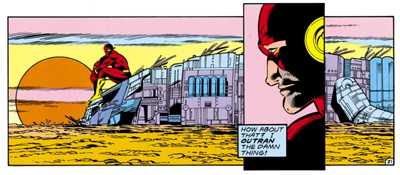





I have #4 flash 87
Cool!
Mr, Gomez is my favorite flash character of all time. He moves with such grace and momentum.
Hi. could someone please tell me where killg%re makes its first comic appereance? I have been looking for that story in years. thx 🙂